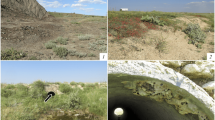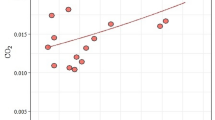Summary
Lasius fuliginosus nests in hollow trees which it divides into chambers by building thin walls. The material used, usually wood but occasionally soil particles, is intermixed and overgrown by fungus mycelium (Cladosporium myrmecophilum). It was shown by thin-layer chromatography that, contrary to current opinion, the secretion of mandibular glands is not part of the building material. Tracer experiments as well as chromatography demonstrated convincingly that collected honey-dew as well as supplied sugar-water were used as a glue. This glue not only held the wood and soil particles together but also provided a culture medium for the fungus. During the construction of the nest chambers three type of workers cooperated: builders, carriers of solid material, and honey-dew-collectors.
Zusammenfassung
Lasius fuliginosus besiedelt hohle Baumstämme, die sie mit einem kartonartigen Material unterkammert. Der Karton besteht aus Holz — bisweilen auch aus Erdteilen und ist von einem Pilzmycel (Cladosporium myrmecophilum) durchwachsen. Die dünnschichtchromatographische Analyse ergab, daß nicht, wie bisher angenommen, das Mandibeldrüsensekret zum Kartonbau verwendet wird. Statt dessen wird, wie chromatographische Untersuchungen und Tracerversuche zeigten, mit eingeschlepptem Honigtau bzw. an die Ameisen verfüttertem Zuckerwasser das Kartonmaterial verklebt. Das Zuckerwasser stellt gleichzeitig das Nährmedium für den Nestpilz dar. Der Karton wird in Arbeitsteilung errichtet, wobei man 3 Arbeitergruppen unterscheiden kann: Bautiere, Festmaterialträger und Honigsammler.
Similar content being viewed by others
Literatur
Ayre, G. L.: Feeding behaviour and digestion in Camponotus herculeanus L. Ent. exp. & appl. 6, 165–170 (1963).
Bernardi, R., Cardani, C., Ghiringhelli, D., Selva, A., Baggini, A., Pavan, M.: On the components of secretion of mandibular glands of the ant Lasius fuliginosus. Tetrahedron Letters 40, 3893–3896 (1967).
Carthy, J. D.: The orientation of two allied species of British ants. II. Odour trail laying and following in Acanthomyops (Lasius) fuliginosus. Behaviour 3, 304–318 (1951).
Eidmann, H.: Die Überwinterung der Ameisen. Z. Morph. Ökol. Tiere 39, 217–275 (1943).
Escherisch, K.: Die Ameise. Braunschweig: Friedr. Viehweg & Sohn 1917.
Forel, A.: Die Welt der Ameisen. Übersetzung von H. Kutter. Zürich: Rotapfel 1948.
Hangartner, W.: Spezifität und Inaktivierung des Spurpheromons von Lasius fuliginosus Latr. und Orientierung der Arbeiterinnen im Duftfeld. Z. vergl. Physiol. 57, 103–136 (1967).
Kloft, W., Maurizio, A., Kalser, W.: Das Waldhonigbuch. München: Ehrenwirth 1965.
Kutter, H.: Miscellanea myrmecologica. III. Mitt. schweiz. entomol. Ges. 37, 127–137 (1964).
Lagerheim, G.: Über Lasius fuliginosus und seine Pilzzucht. Entomol. Tidskr. 21, 17–29 (1900).
Maidl, F.: Lebensgewohnheiten und Instinkte der staatenbildenden Insekten. Wien: Wagner 1934.
Meinert, F.: Bidrag til de danske Myrer. Naturhistorie Kopenhagen 1860. Zit. in Lagerheim 1900.
Mokrasch, L. C.: Analysis of hexosephosphate and sugar mixtures with the anthrone reagent. J. biol. Chem. 208, 55–59 (1954).
Pavan, M.: La Dendrolasina. Notiziario Forestale e Montano 64, 1737–1740 (1959).
Paulsen, R.: Trehalase in den Labialdrüsen von Formica polyctena F. (Hymenoptera, Formicidae). Naturwissenschaften 53, 337–338 (1966).
- Zur Funktion der Propharynx-, Postpharynx- und Labialdrüsen von Formica polyctena. Diss. Würzburg, 1969.
Stahl, E.: Dünnschichtchromatographie, ein Laboratoriumshandbuch, 2. Aufl. Berlin-Heidelberg-New York: Springer 1967.
Stitz, H.: Ameisen oder Formicidae in: Dahl, F., Tierwelt Deutschlands. Jena: Gustav Fischer 1939.
Sudd, J. H.: An introduction to the behaviour of ants. London: Edward Arnold (Publishers) Ltd. 1967.
Wasmann, E.: Lasius emarginatus Ol., eine kartonnestbauende Ameise. Biol. Zbl. 33, 264–266 (1913).
Author information
Authors and Affiliations
Additional information
Mit Unterstützung der Deutschen Forschungsgemeinschaft.
Herrn Prof. Lindauer danken wir für die Durchsicht des Manuskripts, Frl. H. Engel und Frau D. zu Sayn Wittgenstein für technische Hilfe.
Rights and permissions
About this article
Cite this article
Maschwitz, U., Hölldobler, B. Der Kartonnestbau bei Lasius fuliginosus Latr. (Hym. Formicidae). Z. Vergl. Physiol. 66, 176–189 (1970). https://doi.org/10.1007/BF00297777
Received:
Issue Date:
DOI: https://doi.org/10.1007/BF00297777




